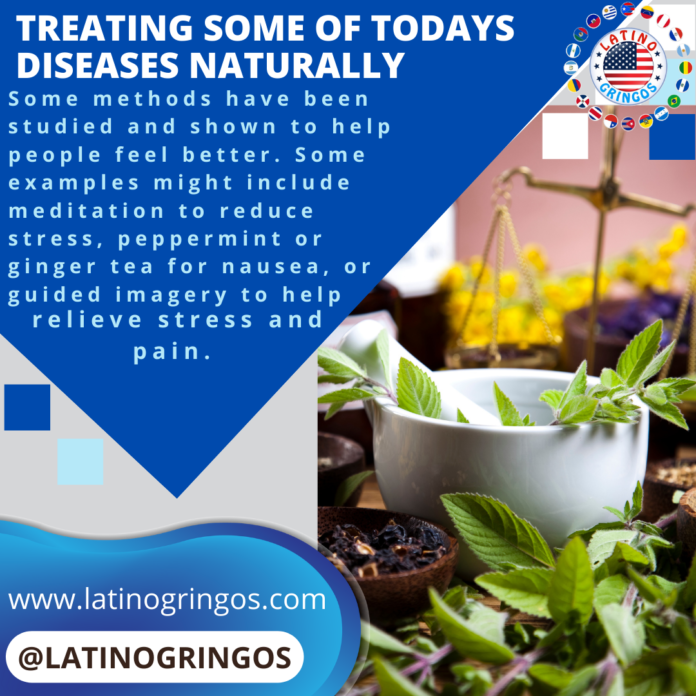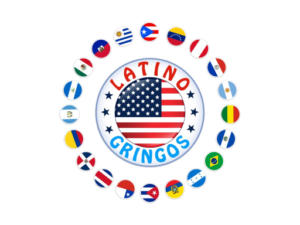Natural medicine is a newer way that we at Healthy Boricuas describe as the prevention and treatment of disease through healthy eating, physical activity, and other healthy behaviors without the use of medication.
In this article, we will share with you some natural ways to treat most of today’s common health problems without the use of traditional medicine. Yes, you can treat almost anything health-related with natural remedies. Some methods have been studied and shown to help people feel better. Some examples might include meditation to reduce stress, peppermint or ginger tea for nausea, or guided imagery to help relieve stress and pain. 
- Diseases of the respiratory system, such as colds, coughs, flu, inflammations of the throat, calm down using plants such as eucalyptus (Eucalyptus urograndis), Zaragoza (Glycyrrhiza glabra), plantain (Plantago major), garlic (Allium sativum), air leaf (Kalanchoe pinata), lemon (Citrus limon), carambola (Averrhoa carambola), used in the form of infusion and syrup, cough, flu, and colds are the most frequent conditions that are treated with plant extracts.
- Cardiocirculatory diseases, present a high frequency of consumption of medicinal herbs for its treatment, mainly for problems of the heart, poor circulation and purification of the blood, for which they use plants such as lemon balm (Melissa officinalis), zaragoza (Glycyrrhiza glabra), mint (Mentha spicata), celery (Apium graveolens), oregano (Origanum vulgare L.).
- Acute and chronic inflammation, such as inflammation in general, inflammation of the urinary tract and kidneys are treated with plantain (Plantago major), mallow (tradescantia spathacea), camomile (Chamaemelum Nobile L.), beldaco (Pseudobombax millei), bototillo (Crescentia cujete), and mainly aloe vera (Aloe vera L.), from the which use the leaves and, in the case of the chamomile, the whole plant in the form of infusion and juices. Like other studies, Aloe vera L. and Chamaemelum nobile L. stand out among the plants that is used in the treatment of inflammations (5). Chamaemelum Nobile L. is also used to alleviate headaches and menstrual pain
- Immunological diseases such as diabetes, is treated with the sour cane (Costus villosissimus), and for cancer, they use plants such as soursop (Annona muricata), cabbage (Brassica oleracea) and noni (Morinda citrifolia L.). Studies Others maintain that medicinal plants or their extracts can optimize glucose metabolism and comprehensive condition of diabetics, not only for its hypoglycemic effects but also by improving the lipid profile.
- Hyperlipidemic diseases as cholesterol and triglycerides, are relieved mainly with flaxseed (Linum usitatissimum L.), breadfruit (Artocarpus altilis), cucumber (Cucumis sativus), celery (Apium graveolens), basil (Ocimum basilicum), purslane (Portulaca oleracea L.), mastranthus (Lippia alba), aloe (Aloe vera);
- Diseases of the sensory system, such as headache, ear, are treated with cinnamon (Cinnamomum zeylanicum), air leaf (Kalanchoe pinnata), plantain (Plantago major), peppermint (Mentha spicata), noni (Morinda citrifolia L.), Castile rue (Ruta graveolens), oregano (Origanum vulgare L.), of which the stem, leaves, and flowers are used, and are administered orally and topically.
- To calm the nerves, use lemon verbena (Cymbopogon citratus), cinnamon (Cinnamomum zeylanicum), lemon (Citrus limon), oregano (Origanum vulgare L.) and valerian (Valeriana officinalis). From the first, they use the leaves, from the second they use the shells, from the third they use the fruit, of the last two they use the leaves, in the form of cooking and administered orally.
Practicing methods have been studied and shown to help people feel better. Some examples might include meditation to reduce stress, peppermint or ginger tea for nausea, or guided imagery to help relieve stress and pain. These practices have a marked cultural behavior, where beliefs and traditions prevail that make medicinal plants be used permanently and that also become a starting point for the search for successful strategies in the conservation of the health of the rural populations.
To see more articles about these topics or others, keep coming back to Latino Gringos™. Make sure to follow us on our Instagram or Facebook to know when we upload new articles or videos.
If you know anyone that might benefit from our articles, even if they are not Latino, please share with them. We love our Latino community, but also like helping anyone that needs it.
La medicina natural es una forma más nueva que nosotros en Healthy Boricuas describimos como la prevención y el tratamiento de enfermedades a través de una alimentación saludable, actividad física y otros comportamientos saludables sin el uso de medicamentos.
En este artículo, compartiremos con usted algunas formas naturales de tratar la mayoría de los problemas de salud comunes de hoy en día sin el uso de la medicina tradicional. Sí, puedes tratar casi cualquier cosa relacionada con la salud con remedios naturales. Se han estudiado y demostrado que algunos métodos ayudan a las personas a sentirse mejor. Algunos ejemplos pueden incluir meditación para reducir el estrés, té de menta o jengibre para las náuseas, o visualización guiada para ayudar a aliviar el estrés y el dolor. 
- Enfermedades del sistema respiratorio, como resfriados, tos, gripe, inflamaciones de garganta, calma utilizando plantas como el eucalipto (Eucalyptus urograndis), Zaragoza (Glycyrrhiza glabra), plátano (Plantago major), ajo (Allium sativum), hoja de aire (Kalanchoe pinata), limón (Citrus limon), carambola (Averrhoa carambola), utilizada en forma de infusión y jarabe, la tos, la gripe y los resfriados son las afecciones más frecuentes que se tratan con extractos de plantas.
- Las enfermedades cardiocirculatorias, presentan una alta frecuencia de consumo de hierbas medicinales para su tratamiento, principalmente para problemas del corazón, mala circulación y depuración de la sangre, para lo cual utilizan plantas como la melisa (Melissa officinalis), zaragoza (Glycyrrhiza glabra), menta (Mentha spicata), apio (Apium graveolens), orégano (Origanum vulgare L.).
- Inflamación aguda y crónica, como la inflamación en general, la inflamación de las vías urinarias y los riñones se tratan con llantén (Plantago major), malva (tradescantia spathacea), manzanilla (Chamaemelum Nobile L.), beldaco (Pseudobombax millei), bototillo (Crescentia cujete), y principalmente aloe vera (Aloe vera L.), de la que utilizan las hojas y, en el caso de la manzanilla, toda la planta en forma de infusiones y jugos. Al igual que otros estudios, Aloe vera L. y Chamaemelum nobile L. destacan entre las plantas que se utiliza en el tratamiento de inflamaciones. Chamaemelum Nobile L. también se utiliza para aliviar dolores de cabeza y dolor menstrual
- Enfermedades inmunológicas como la diabetes, se trata con la caña agria (Costus villosissimus), y para el cáncer se utilizan plantas como la guanábana (Annona muricata), la col (Brassica oleracea) y noni (Morinda citrifolia L.). Estudios Otros sostienen que las plantas medicinales o sus extractos pueden optimizar el metabolismo de la glucosa y el estado integral de los diabéticos, no solo por sus efectos hipoglucemiantes sino también mejorando el perfil lipídico.
- Enfermedades hiperlipidémicas como el colesterol y los triglicéridos, son aliviado principalmente con linaza (Linum usitatissimum L.), fruta del pan (Artocarpus altilis), pepino (Cucumis sativus), apio (Apium graveolens), albahaca (Ocimum basilicum), verdolaga (Portulaca oleracea L.), mastranthus (Lippia alba), aloe (Aloe vera);
- Enfermedades del sistema sensorial, como dolor de cabeza, oreja, se tratan con canela (Cinnamomum zeylanicum), hoja de aire (Kalanchoe pinnata), plátano (Plantago major), menta (Mentha spicata), noni (Morinda citrifolia L.), Castilla ruda (Ruta graveolens), orégano (Origanum vulgare L.), de los que se aprovechan el tallo, las hojas y las flores, y se administran por vía oral y tópica.
- Para calmar los nervios, utilice hierba luisa (Cymbopogon citratus), canela (Cinnamomum zeylanicum), limón (Citrus limon), orégano (Origanum vulgare L.) y valeriana (Valeriana officinalis). Del primero usan las hojas, del segundo usan las conchas, del tercero usan la fruta, de los dos últimos usan las hojas, en forma de cocción y administrado por vía oral.
- Otros métodos de práctica han sido estudiados y se ha demostrado que ayudan a las personas a sentirse mejor. Algunos ejemplos pueden incluir meditación para reducir el estrés, té de menta o jengibre para las náuseas, o visualización guiada para ayudar a aliviar el estrés y el dolor.
Estas prácticas tiene un marcado comportamiento cultural, en donde prevalecen las creencias y tradiciones que hacen que las plantas medicinales sean utilizadas de manera permanente y que además se convierten en un punto de partida para la búsqueda de estrategias exitosas en la conservación de la salud de las poblaciones rurales.
Para ver más artículos sobre estos temas u otros, siga visitando Latino Gringos™. Asegúrese de seguirnos en nuestro Instagram o Facebook para saber cuándo cargamos nuevos artículos o vídeos.
Si conoces a alguien que pueda beneficiarse de nuestros artículos, incluso si no son latinos, compártelo con ellos. Amamos a nuestra comunidad latina, pero también nos gusta ayudar a cualquiera que la necesite.










